[연구보고서] 언어장애 시장 규모는 2022년 83.9억 달러에서 2030년 129.0억 달러로 성장할 것으로 전망되며, 2022~2030년 연평균 성장률 5.7%를 기록할 것으로 예상됩니다.
시장 통찰력 및 분석가 관점:
언어 장애는 환자가 다른 사람과 쉽게 소통하는 데 필요한 특정 음성 소리를 형성하거나 만드는 데 문제가 있는 상태입니다. 반면 언어 장애의 경우, 환자는 다른 사람이 전달하려는 메시지나 의미를 이해할 수 없거나 자신의 생각을 제대로 표현하는 데 어려움이 있습니다. 언어 장애는 때때로 행동 또는 감정 장애로 인해 발생할 수 있습니다. 이러한 장애는 세계의 선진국에서 다양한 치료법으로 해결되고 있지만, 저개발 또는 외딴 지역에서는 의료 전문가가 크게 부족하여 언어 장애 시장 성장을 방해하고 있습니다.
성장 동인 및 과제:
언어 장애의 유병률이 증가하고 신경 퇴행성 질환과 뇌졸중의 사례가 증가함에 따라 언어 장애 시장이 성장하고 있습니다. Stuttering Foundation에서 발표한 데이터에 따르면 전 세계 인구의 1%인 8,000만 명 이상이 말을 더듬습니다. 같은 출처에 따르면 모든 어린이의 약 5%가 약 6개월 이상 말을 더듬고, 이 중 약 1%가 장기간 평균 기간을 넘어 말을 더듬습니다.
또한, 국립 청각 장애 및 기타 의사소통 질환 연구소에 따르면, 발음 장애 및 음운 장애와 같은 음성 장애의 유병률은 어린 아동에서 약 8%-–9%이고, 3~17세의 미국 전체 아동의 약 3.3%가 언어 장애를 앓고 있습니다. 따라서 발음 장애, 음운 장애 및 말더듬기와 같은 언어 장애의 유병률이 전 세계적으로 증가하면서 시장 성장이 촉진되고 있습니다. 또한, 언어 치료를 위한 인공 지능의 사용은 향후 몇 년 동안 새로운 언어 장애 시장 트렌드를 가져올 것으로 예상됩니다.
귀하의 요구 사항에 맞게 이 보고서를 사용자 정의하세요
이 보고서의 일부 또는 국가 수준 분석, Excel 데이터 팩을 포함하여 모든 보고서에 대한 사용자 정의를 무료로 받을 수 있으며 신생 기업 및 대학을 위한 훌륭한 혜택과 할인 혜택을 이용할 수 있습니다.
- 이 보고서의 주요 시장 동향을 알아보세요.이 무료 샘플에는 시장 동향부터 추정 및 예측까지 다양한 데이터 분석이 포함됩니다.
보고서 세분화 및 범위:
언어 장애 시장 분석은 다음 세그먼트를 고려하여 수행되었습니다. 유형, 원인, 장애 유형, 연령대, 제공자 및 지역. 유형별로 시장은 하드웨어와 소프트웨어로 나뉩니다. 소프트웨어 세그먼트는 웹 기반 및 앱 기반으로 세분화됩니다. 원인에 따라 시장은 뇌졸중, 부상, 신경 퇴행성 질환 및 기타로 세분화됩니다. 신경 퇴행성 질환 세그먼트는 근위축성 측색 경화증, 파킨슨병 및 헌팅턴병으로 세분화됩니다. 장애 유형에 따라 시장은 발음 장애, 음운 장애, 음성 장애 또는 공명 장애, 언어 장애 및 기타로 구분됩니다.
범주에 따라 시장은 성인과 소아과로 세분화됩니다. 시장은 공급자별로 의료 시설, 언어 치료 센터, 재활 센터 등으로 세분화됩니다. 지리적으로 언어 장애 시장 보고서의 범위는 주로 북미(미국, 캐나다, 멕시코), 유럽(스페인, 영국, 독일, 프랑스, 이탈리아, 유럽의 나머지 지역), 아시아 태평양(한국, 중국, 일본, 인도, 호주, 아시아 태평양의 나머지 지역), 중동 및 아프리카(남아프리카, 사우디 아라비아, UAE, 중동 및 아프리카의 나머지 지역), 남중부 아메리카(브라질, 아르헨티나, 남중부 아메리카의 나머지 지역)로 나뉩니다.
세그먼트 분석:
언어 장애 시장은 유형별로 하드웨어와 소프트웨어로 나뉩니다. 2022년에는 소프트웨어 부문이 시장 점유율을 더 크게 늘렸고 2022~2030년 동안 더 높은 CAGR을 기록할 것으로 예상됩니다.
원인에 따라 시장은 뇌졸중, 부상, 신경퇴행성 질환 및 기타로 세분화됩니다. 신경퇴행성 질환 세그먼트는 파킨슨병, ALS 및 헌팅턴병으로 더 세분화됩니다. 2022년에 뇌졸중 세그먼트는 가장 큰 언어 장애 시장 점유율을 차지했습니다. 신경퇴행성 질환 세그먼트는 2022~2030년 동안 가장 높은 CAGR을 기록할 것으로 예상됩니다.
장애 유형에 따라 시장은 발음 장애, 음성 장애, 음성 장애 또는 공명 장애, 언어 장애 등으로 구분됩니다. 2022년에 발음 장애 부문은 언어 장애 시장에서 가장 큰 시장 점유율을 차지했습니다. 그러나 같은 부문이 2022~2030년 동안 가장 높은 CAGR을 기록할 것으로 예상됩니다.
범주에 따라 언어 장애 시장은 성인과 소아과로 나뉩니다. 2022년에는 소아과 부문이 시장 점유율이 더 높았으며 2022~2030년 동안 더 높은 CAGR을 기록할 것으로 예상됩니다.
시장은 공급자별로 의료 시설, 언어 치료 센터, 재활 센터 등으로 세분화됩니다. 2022년에 의료 시설 부문은 가장 큰 언어 장애 시장 점유율을 차지했으며 2022~2030년 동안 가장 높은 CAGR을 기록할 것으로 예상됩니다.
지역 분석:
지리적으로 시장은 북미, 유럽, 아시아 태평양, 중동 및 아프리카, 남미 및 중미로 구분됩니다. 북미는 글로벌 언어 장애 시장에 가장 큰 기여를 합니다. 아시아 태평양은 2022~2030년 동안 시장에서 가장 높은 CAGR을 보일 것으로 예상됩니다. 북미는 신경 퇴행성 질환의 증가, 앱 기반 언어 치료 사용 증가, 유창하지 못함과 같은 언어 장애 의 유병률 증가 , 주요 시장 참여자의 존재로 인해 2022년 글로벌 시장에서 가장 큰 점유율을 차지했습니다. 북미에서 미국은 2022년 시장에서 가장 큰 점유율을 차지했습니다.
언어 장애 시장 지역 통찰력
Insight Partners의 분석가들은 예측 기간 동안 언어 장애 시장에 영향을 미치는 지역적 추세와 요인을 철저히 설명했습니다. 이 섹션에서는 북미, 유럽, 아시아 태평양, 중동 및 아프리카, 남미 및 중미의 언어 장애 시장 세그먼트와 지리에 대해서도 설명합니다.

- 언어 장애 시장에 대한 지역별 데이터 얻기
언어 장애 시장 보고서 범위
| 보고서 속성 | 세부 |
|---|---|
| 2022년 시장 규모 | 83억 9천만 달러 |
| 2030년까지 시장 규모 | 129억 달러 |
| 글로벌 CAGR (2022-2030) | 5.7% |
| 역사적 데이터 | 2020-2022 |
| 예측 기간 | 2022-2030 |
| 다루는 세그먼트 | 유형별로
|
| 포함된 지역 및 국가 | 북아메리카
|
| 시장 선도 기업 및 주요 회사 프로필 |
|
언어 장애 시장 참여자 밀도: 비즈니스 역학에 미치는 영향 이해
언어 장애 시장은 소비자 선호도의 변화, 기술 발전, 제품의 이점에 대한 인식 증가와 같은 요인으로 인해 최종 사용자 수요가 증가함에 따라 빠르게 성장하고 있습니다. 수요가 증가함에 따라 기업은 제품을 확장하고, 소비자의 요구를 충족하기 위해 혁신하고, 새로운 트렌드를 활용하여 시장 성장을 더욱 촉진하고 있습니다.
시장 참여자 밀도는 특정 시장이나 산업 내에서 운영되는 회사나 기업의 분포를 말합니다. 주어진 시장 공간에 얼마나 많은 경쟁자(시장 참여자)가 존재하는지 그 규모나 총 시장 가치에 비해 나타냅니다.
언어 장애 시장에서 활동하는 주요 회사는 다음과 같습니다.
- 택터스 테라피 솔루션 유한회사
- 가상 스피치 센터
- 메코 그룹
- MyTalkTools 모바일
- 아이커뮤니케이트
면책 조항 : 위에 나열된 회사는 어떤 특별한 순서에 따라 순위가 매겨지지 않았습니다.

- 언어 장애 시장 주요 주요 업체 개요를 알아보세요
산업 발전 및 미래 기회:
언어 장애 시장 예측은 주요 회사 간행물, 협회 데이터, 데이터베이스와 같은 다양한 2차 및 1차 연구 결과를 기반으로 추정됩니다. 언어 장애 시장에서 활동하는 주요 업체의 전략은 다음과 같습니다.
- 2021년 8월, CHOC는 UC Irvine의 정보 및 컴퓨터 과학부(ICS)의 학부 4학년 학생들의 도움을 받아 개발한 언어 치료 앱에 대한 파일럿 연구를 시작했습니다. Amplify는 모험 게임을 사용하여 임상의와 환자 모두에게 언어 치료를 보다 편리하고, 매력적이며, 상호 작용적으로 만들도록 설계된 앱입니다. 이 앱은 스토리라인에 내장된 언어 기술을 향상시키기 위한 상호 작용적이고 청각적인 모험 연습의 포괄적인 라이브러리를 호스팅합니다.
경쟁 환경 및 주요 회사:
Tactus Therapy Solutions Ltd, Virtual Speech Center, The Meco Group, MyTalkTools Mobile, iCommunicate, iConverse, Skylineinnovation, Speak Up, Proloquo2Go, Talkitt는 언어 장애 시장 보고서에 소개된 주요 기업입니다. 또한, 시장과 생태계에 대한 전체적인 관점을 얻기 위해 연구 기간 동안 여러 다른 기업을 연구하고 분석했습니다. 이러한 기업은 전 세계 소비자의 증가하는 수요를 충족하고 특수 포트폴리오에서 제품 범위를 늘리기 위해 지리적 확장과 신제품 출시에 집중합니다. 글로벌 입지를 통해 광범위한 고객 기반을 제공할 수 있어 시장 확장이 용이해집니다.
- 역사적 분석(2년), 기준 연도, CAGR을 포함한 예측(7년)
- PEST 및 SWOT 분석
- 시장 규모 가치/양 - 글로벌, 지역, 국가
- 산업 및 경쟁 환경
- Excel 데이터 세트



Report Coverage
Revenue forecast, Company Analysis, Industry landscape, Growth factors, and Trends

Segment Covered
This text is related
to segments covered.

Regional Scope
North America, Europe, Asia Pacific, Middle East & Africa, South & Central America

Country Scope
This text is related
to country scope.
자주 묻는 질문
Growing prevalence of speech and language disorders and increasing cases of neurodegenerative diseases and stroke propel the market growth. However, the unavailability of speech therapy in underdeveloped or remote areas and the lack of healthcare professionals are hampering the growth of the market. The use of artificial intelligence for speech and language therapy is expected to bring new speech and language disorder market trends in the coming years.
Speech disorder is a condition in which the patient has a problem in forming or creating particular speech sounds required to communicate with others easily. Whereas, in language disorder, the person cannot understand the message or meaning the other person is trying to convey or has difficulty in expressing their thought properly. Speech and language disorders may sometimes occur due to behavioral or emotional disorders. Although these disorders are being addressed with various therapies in developed parts of the world, there is a significant shortage of healthcare professionals in underdeveloped or remote areas, which is hampering the speech and language disorder market growth.
Based on geography, the speech and language disorder market is segmented into North America (the US, Canada, and Mexico), Europe (the UK, Germany, France, Italy, Spain, and the Rest of Europe), Asia Pacific (China, Japan, India, South Korea, Australia, and the Rest of Asia Pacific), the Middle East & Africa (the UAE, Saudi Arabia, South Africa, and Rest of the Middle East & Africa), and South & Central America (Brazil, Argentina, and the Rest of South & Central America). North America is the largest contributor to the growth of the global speech and language disorder market. Asia Pacific is expected to register the highest CAGR in the speech and language disorder market during 2022–2030.
The speech and language disorder market majorly consists of the players such Tactus Therapy Solutions Ltd, Virtual Speech Center, The Meco Group, MyTalkTools Mobile, iCommunicate, iConverse, Skylineinnovation, Speak Up, Proloquo2Go, and Talkitt.
The speech and language disorder market, by type, is bifurcated into hardware and software. The software segment is further divided into web-based and app-based. In 2022, the software segment held a larger share of the market and is expected to record a higher CAGR during 2022–2030.
Based on cause, the market is segmented into stroke, injury, neurodegenerative diseases, and others. The neurodegenerative diseases segment is further divided into Parkinson's disease, amyotrophic lateral sclerosis, and Huntington's disease. In 2022, the stroke segment held the largest speech and language disorder market share. However, the neurodegenerative diseases segment is expected to record the highest CAGR during 2022–2030.
Based on disorder type, the market is divided into articulation disorders, phonological disorders, voice disorders or resonance disorders, language disorders, and others. In 2022, the articulation disorders segment held the largest share of the speech and language disorder market and is expected to record the highest CAGR during 2022–2030.
Based on category, the speech and language disorder market is bifurcated into adults and pediatric. In 2022, the pediatric segment held a larger share of the market and is expected to record a higher CAGR during 2022–2030.
The market, by provider, is segmented into healthcare facilities, speech therapy centers, rehabilitation centers, and others. In 2022, the healthcare facilities segment held the largest share of the speech market and is expected to record the highest CAGR during 2022–2030.
Trends and growth analysis reports related to Technology, Media and Telecommunications : READ MORE..
The List of Companies - Speech and Language Disorder Market
- Tactus Therapy Solutions Ltd
- Virtual Speech Center
- The Meco Group
- MyTalkTools Mobile
- iCommunicate
- iConverse
- Skylineinnovation
- Speak Up
- Proloquo2Go
- Talkitt
The Insight Partners performs research in 4 major stages: Data Collection & Secondary Research, Primary Research, Data Analysis and Data Triangulation & Final Review.
- Data Collection and Secondary Research:
As a market research and consulting firm operating from a decade, we have published and advised several client across the globe. First step for any study will start with an assessment of currently available data and insights from existing reports. Further, historical and current market information is collected from Investor Presentations, Annual Reports, SEC Filings, etc., and other information related to company’s performance and market positioning are gathered from Paid Databases (Factiva, Hoovers, and Reuters) and various other publications available in public domain.
Several associations trade associates, technical forums, institutes, societies and organization are accessed to gain technical as well as market related insights through their publications such as research papers, blogs and press releases related to the studies are referred to get cues about the market. Further, white papers, journals, magazines, and other news articles published in last 3 years are scrutinized and analyzed to understand the current market trends.
- Primary Research:
The primarily interview analysis comprise of data obtained from industry participants interview and answers to survey questions gathered by in-house primary team.
For primary research, interviews are conducted with industry experts/CEOs/Marketing Managers/VPs/Subject Matter Experts from both demand and supply side to get a 360-degree view of the market. The primary team conducts several interviews based on the complexity of the markets to understand the various market trends and dynamics which makes research more credible and precise.
A typical research interview fulfils the following functions:
- Provides first-hand information on the market size, market trends, growth trends, competitive landscape, and outlook
- Validates and strengthens in-house secondary research findings
- Develops the analysis team’s expertise and market understanding
Primary research involves email interactions and telephone interviews for each market, category, segment, and sub-segment across geographies. The participants who typically take part in such a process include, but are not limited to:
- Industry participants: VPs, business development managers, market intelligence managers and national sales managers
- Outside experts: Valuation experts, research analysts and key opinion leaders specializing in the electronics and semiconductor industry.
Below is the breakup of our primary respondents by company, designation, and region:

Once we receive the confirmation from primary research sources or primary respondents, we finalize the base year market estimation and forecast the data as per the macroeconomic and microeconomic factors assessed during data collection.
- Data Analysis:
Once data is validated through both secondary as well as primary respondents, we finalize the market estimations by hypothesis formulation and factor analysis at regional and country level.
- Macro-Economic Factor Analysis:
We analyse macroeconomic indicators such the gross domestic product (GDP), increase in the demand for goods and services across industries, technological advancement, regional economic growth, governmental policies, the influence of COVID-19, PEST analysis, and other aspects. This analysis aids in setting benchmarks for various nations/regions and approximating market splits. Additionally, the general trend of the aforementioned components aid in determining the market's development possibilities.
- Country Level Data:
Various factors that are especially aligned to the country are taken into account to determine the market size for a certain area and country, including the presence of vendors, such as headquarters and offices, the country's GDP, demand patterns, and industry growth. To comprehend the market dynamics for the nation, a number of growth variables, inhibitors, application areas, and current market trends are researched. The aforementioned elements aid in determining the country's overall market's growth potential.
- Company Profile:
The “Table of Contents” is formulated by listing and analyzing more than 25 - 30 companies operating in the market ecosystem across geographies. However, we profile only 10 companies as a standard practice in our syndicate reports. These 10 companies comprise leading, emerging, and regional players. Nonetheless, our analysis is not restricted to the 10 listed companies, we also analyze other companies present in the market to develop a holistic view and understand the prevailing trends. The “Company Profiles” section in the report covers key facts, business description, products & services, financial information, SWOT analysis, and key developments. The financial information presented is extracted from the annual reports and official documents of the publicly listed companies. Upon collecting the information for the sections of respective companies, we verify them via various primary sources and then compile the data in respective company profiles. The company level information helps us in deriving the base number as well as in forecasting the market size.
- Developing Base Number:
Aggregation of sales statistics (2020-2022) and macro-economic factor, and other secondary and primary research insights are utilized to arrive at base number and related market shares for 2022. The data gaps are identified in this step and relevant market data is analyzed, collected from paid primary interviews or databases. On finalizing the base year market size, forecasts are developed on the basis of macro-economic, industry and market growth factors and company level analysis.
- Data Triangulation and Final Review:
The market findings and base year market size calculations are validated from supply as well as demand side. Demand side validations are based on macro-economic factor analysis and benchmarks for respective regions and countries. In case of supply side validations, revenues of major companies are estimated (in case not available) based on industry benchmark, approximate number of employees, product portfolio, and primary interviews revenues are gathered. Further revenue from target product/service segment is assessed to avoid overshooting of market statistics. In case of heavy deviations between supply and demand side values, all thes steps are repeated to achieve synchronization.
We follow an iterative model, wherein we share our research findings with Subject Matter Experts (SME’s) and Key Opinion Leaders (KOLs) until consensus view of the market is not formulated – this model negates any drastic deviation in the opinions of experts. Only validated and universally acceptable research findings are quoted in our reports.
We have important check points that we use to validate our research findings – which we call – data triangulation, where we validate the information, we generate from secondary sources with primary interviews and then we re-validate with our internal data bases and Subject matter experts. This comprehensive model enables us to deliver high quality, reliable data in shortest possible time.


 이 보고서에 대한 무료 샘플을 받으세요
이 보고서에 대한 무료 샘플을 받으세요